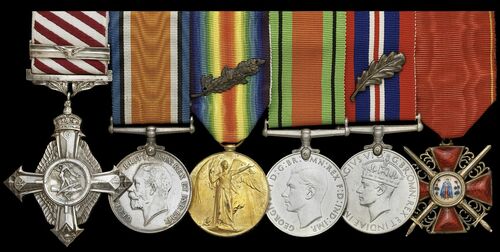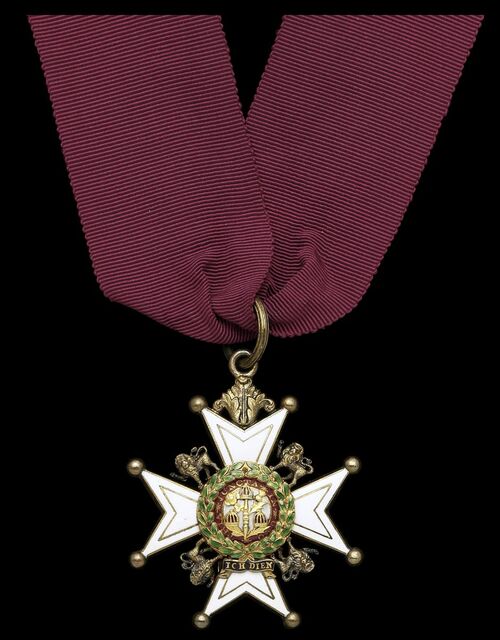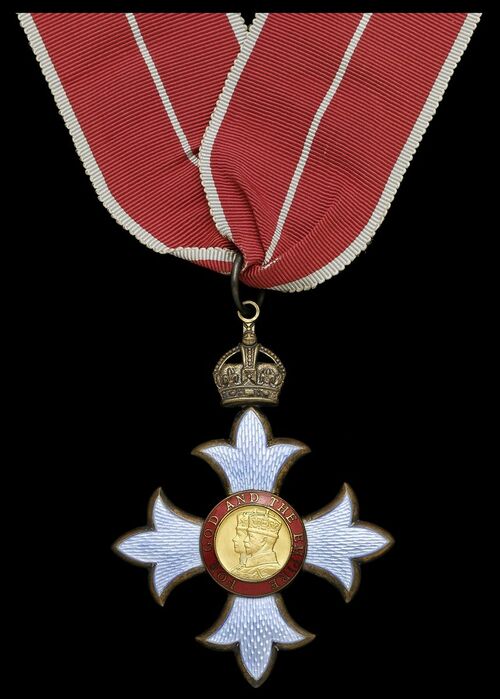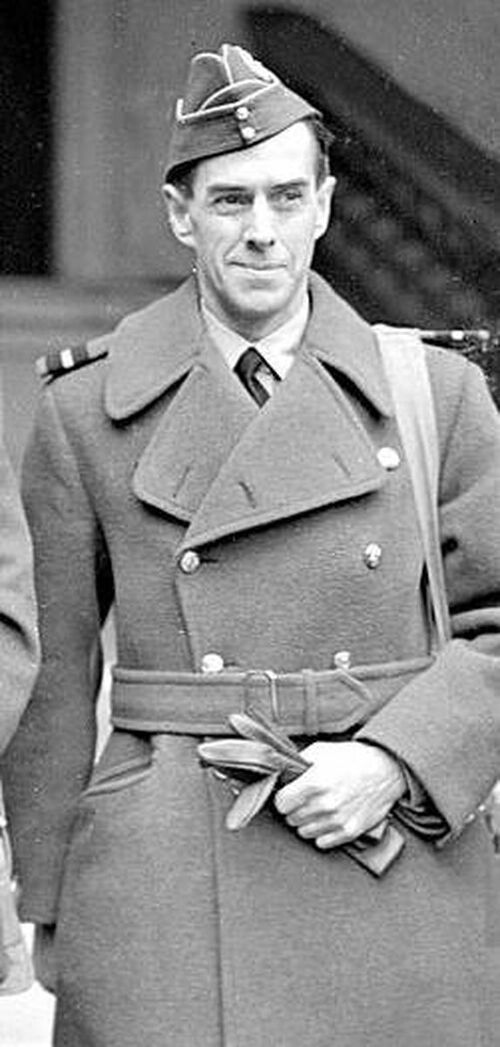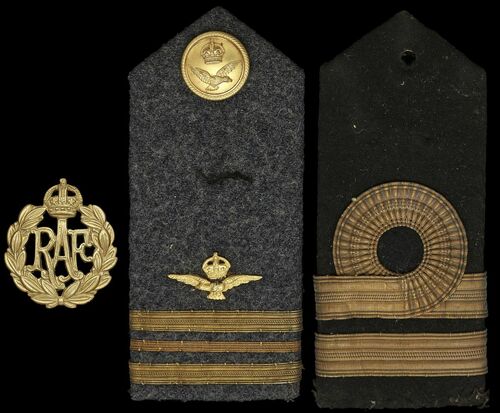Auction: 23003 - Orders, Decorations and Medals
Lot: 304
The Second World War C.B., C.B.E., Great War A.F.C. and Inter-War Second Award Bar group of eight awarded to Air Vice-Marshal E. S. Goodwin, Royal Air Force, Director General of Training (Air), late Director of Operational Training, Royal Air Force, who was additionally 'mentioned' for his service in North Russia, when he flew Seaplanes off the Nairana and was awarded an Order of St Anne
The Most Honourable Order of the Bath, Companion's (C.B) neck Badge, silver-gilt and enamel; The Most Excellent Order of the British Empire, Military Division, 2nd Type, Commander's (C.B.E.) neck Badge, silver-gilt and enamel; Air Force Cross, G.V.R., with Second Award Bar; British War and Victory Medals, with M.I.D. oak leaves (Capt. E. S. Goodwin. R.A.F.); Defence and War Medals 1939-45, with M.I.D. oak leaf; Russia, Imperial, Order of St Anne, Military Division, Officer's breast Badge, silver-gilt and enamel, mounted as worn very fine or better (Lot)
C.B. London Gazette 8 June 1944.
C.B.E. London Gazette 17 March 1941.
A.F.C. London Gazette 2 November 1918.
Second Award Bar London Gazette 3 June 1933.
M.I.D. London Gazette 3 June 1918; 22 December 1919; 1 January 1941.
Edwin Spencer Goodwin was born on 12 December 1894, and was educated at Miss Smith's (Private) School, Gillingham and then at Sir Joseph Williamson's Mathematical School leaving in July 1913 to become a Dental Pupil at Guy's Hospital. With the outbreak of the Great War he was commissioned into the Royal Naval Air Service on 28 May 1916 as a Flight Sub-Lieutenant and took Royal Aero Club Certificate No. 3333 on 3 August 1916.
Completing his Seaplane course on 10 November 1916, his confidential notes comment on his skill as a pilot. Consequently, he was transferred to the role of Naval Test Pilot at Grain Aero Station, testing new models of seaplanes and he seemed to specialise in armaments.
Goodwin became unhappy with the lack of active service, so much so that in September 1917 he sent a letter to higher command threatening to resign his Commission if he was not given some sort of combat service. Promoted Flight Lieutenant on 1 October 1917, he was commissioned into the Royal Air Force upon its formation and detached to Russia as part of the Allied Intervention.
He sailed to Russia in 1918 aboard Nairana a seaplane carrier to participate in the North Russia Campaign in support of the British intervention in the Russian Civil War. She took part in what was probably the first fully combined air, sea and land military operation in history on 1 August, when she and her Campania seaplanes joined Allied ground forces and other ships in driving the Bolsheviks out of their fortifications on Modyugski Island at the mouth of the Northern Dvina River. Nairana used her own guns on the Bolshevik batteries, (before she and her aircraft scouted before the Allied force....) she and her aircraft then scouted ahead of the Allied force as it proceeded up the channel to Arkhangelsk. The appearance of one of her Campanias over Arkhangelsk caused the Bolshevik troops there to panic and abandon the city. Nairana sustained no damage during the assault. As of October, the ship was carrying five Campanias and two Sopwith Babies, although these last two aircraft were replaced by Sopwith Camels in 1919.
Nairana was refitting in Rosyth (by May 1919). She then ferried a flight of Fairey IIIC floatplanes to North Russia for use by the Royal Air Force later in the month. Remaining at Murmansk for several weeks before proceeding on to Kem. There the ship was inspected by Rear-Admiral John Green, Rear-Admiral Commanding in the White Sea, on 29 July. Nairana proceeded to Onega at the end of August, where her aircraft observed for the monitor Erebus as the latter bombarded the town for several days before returning to Kem. She departed Russia on 8 October and arrived back at Rosyth four days later.
Goodwin transferred to the Unemployed List on 12 October 1919 and promoted to Flight Lieutenant on 28 November 1919 as part of a Short Service Commission. He was 'mentioned' for North Russia as well as earning an Order of St.Anne for his services.
He served as a Pilot with No. 216 Squadron from 24 February 1922 in Egypt and is noted as being a Pilot with No. 480 Squadron (Flying boat) Flight at Calshot in June 1927. He became Flight Commander with No. 201 Squadron on 1 January 1929.
Assuming Command of No. 22 Squadron at Martlesham Heath on 8 January 1929 working with trials aircraft. Further to this he became Officer Commanding No. 15 Squadron on Horsley Trials Aircraft at Martlesham Heath from 23 March 1935 and was shortly afterwards promoted to Wing Commander on 2 July 1935. Appointed Officer Commanding No. 38 Squadron and advanced to Group Captain on 3 January 1939 and to Air Commodore on 28 January 1941 and on 25 March 1941 becomes Director of Operational Training, followed by a posting to become Director-General of Training (Air) on 25 February 1942. He became A.O.A., HQ Bomber Command on 19 November 1945 and was promoted to Air Vice-Marshal on 8 March 1948 and retired the following day. He died on 17 May 1991, aged 96.
Sold together with an archive of original material comprising:
(i)
Warrant for the Order of the Bath.
(ii)
Warrant for the Order of the British Empire.
(iii)
Mentioned in Despatches certificate, dated 31 August 1940.
(iv)
Seven assorted photographs of him in civilian, naval and air force uniform.
(v)
A caricature of him in civilian uniform.
(vi)
A Christmas card from Royal Air Force, Heliopolis.
(v)
Maps from American Airlines and United Air Lines.
(vi)
A copy of the Air Marshals' Club.
(vii)
Epaulettes for greatcoats for Royal Navy and Royal Air Force, and an R.A.F. Other Ranks cap badge.
(viii)
Newspaper cuttings.
Subject to 20% VAT on Buyer’s Premium. For more information please view Terms and Conditions for Buyers.
Estimate
£5,000 to £7,000
Starting price
£4000

